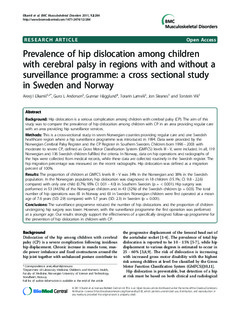| dc.contributor.author | Elkamil, Areej Ibrahim | |
| dc.contributor.author | Andersen, Guro Lillemoen | |
| dc.contributor.author | Hägglund, Gunnar | |
| dc.contributor.author | Lamvik, Torarin | |
| dc.contributor.author | Skranes, Jon | |
| dc.contributor.author | Vik, Torstein | |
| dc.date.accessioned | 2015-09-21T13:11:42Z | |
| dc.date.accessioned | 2016-04-15T13:20:48Z | |
| dc.date.available | 2015-09-21T13:11:42Z | |
| dc.date.available | 2016-04-15T13:20:48Z | |
| dc.date.issued | 2011 | |
| dc.identifier.citation | BMC Musculoskeletal Disorders 2011, 12 | nb_NO |
| dc.identifier.issn | 1471-2474 | |
| dc.identifier.uri | http://hdl.handle.net/11250/2385836 | |
| dc.description.abstract | Background: Hip dislocation is a serious complication among children with cerebral palsy (CP). The aim of this
study was to compare the prevalence of hip dislocation among children with CP in an area providing regular care
with an area providing hip surveillance services.
Methods: This is a cross-sectional study in seven Norwegian counties providing regular care and one Swedish
healthcare region where a hip surveillance programme was introduced in 1994. Data were provided by the
Norwegian Cerebral Palsy Register and the CP Register in Southern Sweden. Children born 1996 - 2003 with
moderate to severe CP, defined as Gross Motor Classification System (GMFCS) levels III - V, were included. In all, 119
Norwegian and 136 Swedish children fulfilled the criteria. In Norway, data on hip operations and radiographs of
the hips were collected from medical records, while these data are collected routinely in the Swedish register. The
hip migration percentage was measured on the recent radiographs. Hip dislocation was defined as a migration
percent of 100%.
Results: The proportion of children at GMFCS levels III - V was 34% in the Norwegian and 38% in the Swedish
population. In the Norwegian population, hip dislocation was diagnosed in 18 children (15.1%; CI: 9.8 - 22.6)
compared with only one child (0.7%; 95% CI: 0.01 - 4.0) in Southern Sweden (p = < 0.001). Hip surgery was
performed in 53 (44.5%) of the Norwegian children and in 43 (32%) of the Swedish children (p = 0.03). The total
number of hip operations was 65 in Norway and 63 in Sweden. Norwegian children were first operated at a mean
age of 7.6 years (SD: 2.9) compared with 5.7 years (SD: 2.3) in Sweden (p = 0.001).
Conclusions: The surveillance programme reduced the number of hip dislocations and the proportion of children
undergoing hip surgery was lower. However, with the surveillance programme the first operation was performed
at a younger age. Our results strongly support the effectiveness of a specifically designed follow-up programme for
the prevention of hip dislocation in children with CP. | nb_NO |
| dc.language.iso | eng | nb_NO |
| dc.publisher | BioMed Central | nb_NO |
| dc.rights | Navngivelse 3.0 Norge | * |
| dc.rights.uri | http://creativecommons.org/licenses/by/3.0/no/ | * |
| dc.title | Prevalence of hip dislocation among children with cerebral palsy in regions with and without a surveillance programme: a cross sectional study in Sweden and Norway | nb_NO |
| dc.type | Journal article | nb_NO |
| dc.type | Peer reviewed | nb_NO |
| dc.date.updated | 2015-09-21T13:11:42Z | |
| dc.source.volume | 12 | nb_NO |
| dc.source.journal | BMC Musculoskeletal Disorders | nb_NO |
| dc.identifier.doi | 10.1186/1471-2474-12-284 | |
| dc.identifier.cristin | 884606 | |
| dc.description.localcode | © Elkamil et al; licensee BioMed Central Ltd. 2011. This is an Open Access article distributed under the terms of the Creative Commons Attribution License (http://creativecommons.org/licenses/by/2.0), which permits unrestricted use, distribution, and reproduction in any medium, provided the original work is properly cited. | nb_NO |

